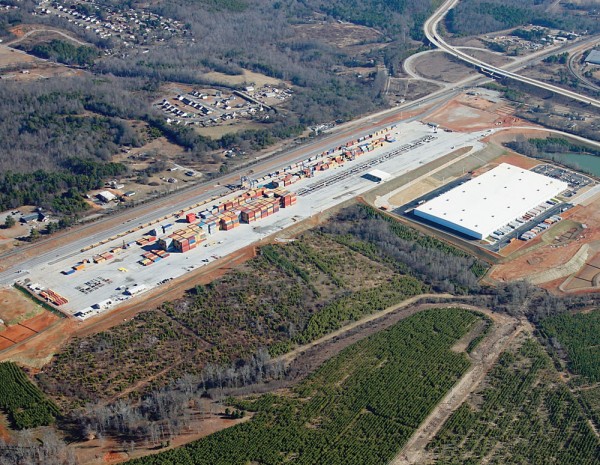As trade grows, so does the need for inland ports.
The South Carolina Ports Authority expects its second inland port, in Dillon, South Carolina, to open in April, a facility slated to support growing intermodal cargo volumes between the Port of Charleston and markets throughout the Carolinas, the Northeast, and the Midwest. The upcoming event will reflect South Carolina’s growth in logistics investments and freight movement.

South Carolina’s are not the only inland ports in the southeast. The Virginia Inland Port, an intermodal container transfer facility owned by the Virginia Port Authority, occupies 161 acres 60 miles west of Washington, D.C. The terminal brings the Port of Virginia 220 miles closer to inland markets and enhances its service to the Washington and Baltimore metropolitan areas.
The South Carolina Ports Authority reported nine percent container volume growth in 2017 with a record-setting 2.2 million TEU, surpassing the previous record of two-million TEU achieved in 2016. Inland Port Greer handled 7,646 rail moves in December, pushing the facility’s volumes to a new calendar year record of 124,817 total rail moves in 2017. Greer experienced 20.4 percent growth over its 2016 volume record of 103,639 rail moves.
The Port of Charleston is already routinely handling neo-panamax containerships, with 13,000 TEU and 14,000 TEU vessels calling on the port in 2017, and is investing in the capacity to handle many more of them. In 2017, the port marked the arrival on May 13 of the COSCO Development, the first 13,000 TEU vessel to call East Coast ports, and on September 14 handled its biggest ship yet, the 14,414 TEU CMA CGM Theodore Roosevelt.
In October 2017, SCPA announced a $69.5-million contract for the purchase of six new ship-to-shore cranes, to be delivered in late 2019 to the Hugh K. Leatherman, Sr. Terminal, the only permitted container terminal under construction on the U.S. East or Gulf coasts. Phase One of the terminal is scheduled to open in mid-2020. Charleston Harbor is also in the process of being deepened to 52 feet.
On top of that, South Carolina’s industrial markets have been booming, coinciding with increased cargo flowing through its port and a large increase in manufacturing in the region, allowing Charleston to claim the top spots on the list of growth markets in the country for industrial real estate. Over three-million square feet of industrial space is under construction or planned, according to a report from Colliers International, a commercial real estate consultancy. All this data provides testimony to South Carolina’s growing prowess in international trade and its need to enhance its logistics infrastructure in order to handle that trade.
“Inland Port Dillon will bring the benefits of efficiency and flexibility to shippers in this area,” said SCPA president and CEO Jim Newsome.
“Global container trade growth was the strongest it has been since 2010, mirroring surprising strength in the global economy,” he added. “We expect to see continued strength, albeit slightly more modest, into 2018 with growth in the emerging market economies as a key factor in sustaining this positive outlook.”
Inland Port Dillon, 160 miles inland from Charleston, near the North Carolina border, in the Pee Dee region of South Carolina, was chosen for is location within the Carolinas I-95 Mega Site and its close proximity to I-95, a critical transportation artery in the Southeast. The area is central to a significant base of existing port users that represent a base of cargo opportunities for the facility. The initial phase is expected to handle at least 45,000 containers annually, offering overnight access to and from Charleston via an existing CSX main line.
The facility’s benefits will also include increased efficiency for importers and exporters, reduced truck traffic on I-26 and I-95 with associated environmental benefits, and a magnet for future economic development in the area. Inland Port Greer has attracted the development of logistics centers from companies as diverse as BMW and Dollar Tree.
Inland Port Dillon will occupy 160 acres and include 10,000 feet of track. Partners in the project include state and local governmental agencies and economic development organizations, Duke Energy, the Marlboro Electrical Cooperative, and CSX Transportation.
“Inland Port Dillon will diversify SCPA’s footprint and enable port users to gain logistics efficiencies through rail transportation of their cargo,” said Newsome. “Building intermodal infrastructure in our state goes hand-in-hand with the significant investment we are making to our port facilities in Charleston. Our facilities in Dillon and Greer are important to SCPA’s overall volume growth and the significant amount of cargo that moves today by rail. Selective development of inland infrastructure enables freight to move more easily and is critical to the growth of the port.”
“Expanding intermodal service in South Carolina through Inland Port Dillon will create a competitive advantage for area businesses by lowering transportation costs and providing greater access to domestic and international markets,” added Dean Piacente, the CSX vice president for intermodal. “This new facility will build on the state of South Carolina’s already strong freight rail network supporting continued business growth and job creation.”





